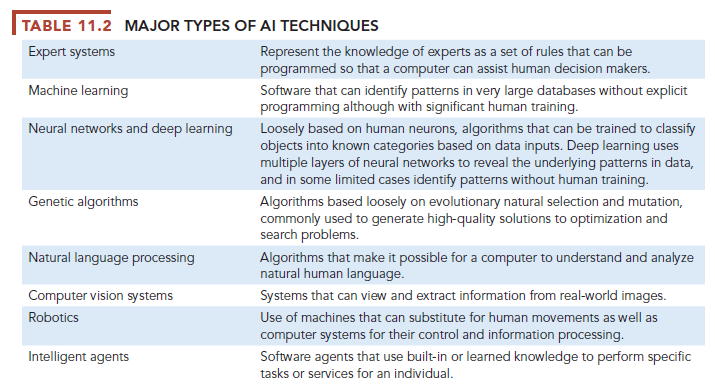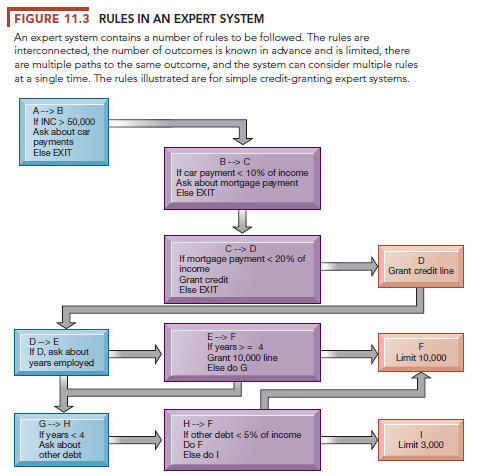Expert systems were developed in the 1970s and were the first large-scale applications of AI in business and other organizations. They account for an estimated 20 percent of all AI systems today. Expert systems capture the knowledge of individual experts in an organization through in-depth interviews, and represent that knowledge as sets of rules. These rules are then converted into computer code in the form of IF-THEN rules. Such programs are often used to develop apps that walk users through a process of decision making.


Expert systems provide benefits such as improved decisions, reduced errors, reduced costs, reduced training time, and better quality and service. They have been used in applications for making decisions about granting credit and for diagnosing equipment problems, as well as in medical diagnostics, legal research, civil engineering, building maintenance, drawing up building plans, and educational technology (personalized learning and responsive testing) (Maor, 2003; Mishra, 2016). For instance, if you were the project manager of a 14-story office building and were given the task of configuring the building’s air conditioning system, which has hundreds of parts and subassemblies, an expert system could walk you through the process by asking a series of questions, producing an order to suppliers, and providing an overall cost estimate for the project, all in a matter of hours rather than weeks. See Figure 11.3 for an expert system for credit granting.
How Expert Systems Work
Expert systems model human knowledge as a set of rules that collectively are called the knowledge base. Expert systems can have from a handful to many thousands of rules, depending on the complexity of the decision-making problem. The strategy used to search through the collection of rules and formulate conclusions is called the inference engine. The inference engine works by searching through the rules and firing those rules that are triggered by facts the user gathers and enters.
Expert systems have a number of limitations, the most important of which is that even experts can’t explain how they make decisions: they know more than they can say. People drive cars, for instance, but are challenged to say how they do it. The knowledge base can become chaotic as the number of rules can reach into the thousands. In rapidly changing environments, say medical diagnosis, the rules change and need to be continually updated. Expert systems are not useful for dealing with unstructured problems that managers and employees typically encounter, and do not use real-time data to guide their decisions. Expert systems do not scale well to the kinds of very large data sets produced by the Internet and the Internet of Things (IoT), and they are expensive to build. For these reasons, expert system development has slowed in the last decade to small domains of expert knowledge such as automobile diagnosis.
Source: Laudon Kenneth C., Laudon Jane Price (2020), Management Information Systems: Managing the Digital Firm, Pearson; 16th edition.

Enjoyed examining this, very good stuff, regards.
I believe other website proprietors should take this site as an example , very clean and fantastic user friendly design and style.